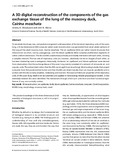| dc.contributor.author | Woodward, Jeremy D | |
| dc.contributor.author | Maina, JN | |
| dc.date.accessioned | 2013-07-23T08:42:17Z | |
| dc.date.available | 2013-07-23T08:42:17Z | |
| dc.date.issued | 2005 | |
| dc.identifier.citation | Journal of Anatomy Volume 206, Issue 5, pages 477–492, May 2005 | en |
| dc.identifier.uri | http://onlinelibrary.wiley.com/doi/10.1111/j.1469-7580.2005.00413.x/full | |
| dc.identifier.uri | http://erepository.uonbi.ac.ke:8080/xmlui/handle/123456789/49991 | |
| dc.description.abstract | To elucidate the shape, size, and spatial arrangement and association of the terminal respiratory units of the avian lung, a three-dimensional (3D) computer-aided voxel reconstruction was generated from serial plastic sections of the lung of the adult muscovy duck, Cairina moschata. The air capillaries (ACs) are rather rotund structures that interconnect via short, narrow passageways, and the blood capillaries (BCs) comprise proliferative segments of rather uniform dimensions. The ACs and BCs anastomose profusely and closely intertwine with each other, forming a complex network. The two sets of respiratory units are, however, absolutely not mirror images of each other, as has been claimed by some investigators. Historically, the terms ‘air capillaries’ and ‘blood capillaries’ were derived from observations that the exchange tissue of the avian lung mainly consisted of a network of minuscule air- and vascular units. The entrenched notion that the ACs are straight (non-branching), blind-ending tubules that project outwards from the parabronchial lumen and that the BCs are direct tubules that run inwards parallel to and in contact with the ACs is overly simplistic, misleading and incorrect. The exact architectural properties of the respiratory units of the avian lung need to be documented and applied in formulating reliable physiological models. A few ostensibly isolated ACs were identified. The mechanism through which such units form and their functional significance, if any, are currently unclear | en |
| dc.language.iso | en | en |
| dc.publisher | Wiley | en |
| dc.subject | 3D reconstruction | en |
| dc.subject | Air capillaries | en |
| dc.subject | Birds | en |
| dc.subject | Blood capillaries | en |
| dc.subject | Cairina moschata | en |
| dc.subject | Computer | en |
| dc.subject | Corel Coorporation | en |
| dc.subject | KS300 | en |
| dc.subject | Lung | en |
| dc.subject | Morphology | en |
| dc.subject | Muscovy duck | en |
| dc.subject | Voxel | en |
| dc.title | A 3D digital reconstruction of the components of the gas exchange tissue of the lung of the muscovy duck, Cairina moschata | en |
| dc.type | Article | en |
| local.publisher | School of Anatomical Sciences, Faculty of Health Sciences, University of the Witwatersrand, Johannesburg, South Africa | en |

